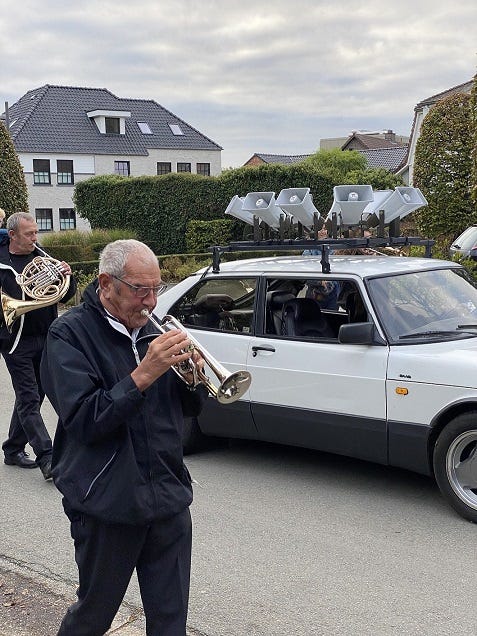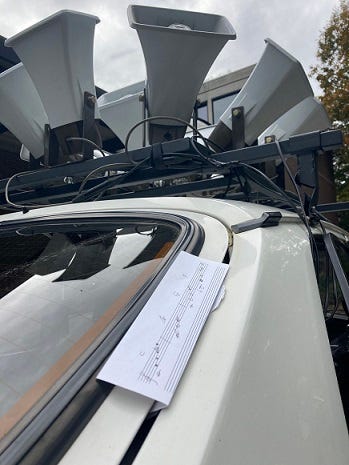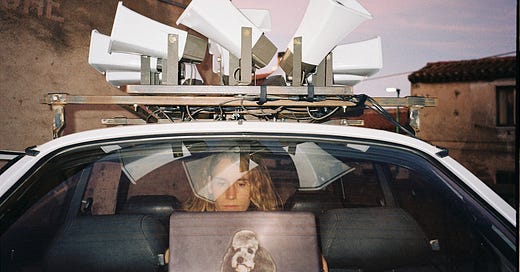Review | “Saab Fanfare” by Amber Meulenijzer feat. Musica Impulscentrum
An otherworldly walk to the periphery of complicity between performance art, live music, and transcendental poetics.

Following is a review of a performance soundtrack composed by Amber Meulenijzer (Belgian, b. 1994), an artist whose multidisciplinary work combines sound, installation, composition, and direction (both in the sense of theatre and orchestra conducting, in this case, a street brass band featuring Alex Vandersanden on horn, Elise Verdonk on trombone, Louis Trippaers on cornet and Tijs Vroman on trumpet)
Her work aims to combine “everyday wonder, intuition and a general curiosity for the limits of different materials, with theatrical, cinematographic and poetic elements”
“Saab Fanfare” is primarily and inextricably linked to its live performance as a 35-minute track recorded in one-take during a singular staging, in the form of a wind quartet following a slow-moving car on foot as it is driven by Meulenijzer herself, heading a public procession through the winding roads of the country village of Pelt in eastern rural Belgium.
According to the liner notes,
“In October 2022 Musica Impulscentrum invited Amber Meulenijzer to make a composition in collaboration with the local fanfare bands of Pelt, a small municipality in the green east of Belgium”
The perambulating pipers flanking the car are locally known as a fanfare band and traditionally perform at public functions and rituals, their forlorn sound being a part of the local folklore.


These fanfare bands are deeply rooted in Belgian culture. Even in the tiniest villages, one finds at least one or several of these ensembles.
The vehicle followed on foot is an old Saab 900, a small, affordable, humble car, once a working-class symbol that still carries a certain dignity in its ergonomic elegance.
Converted into a mobile sound system and impromptu mini-studio by Meulenijzer herself, the entire simple yet ingenious set-up amplifies the ghostliness of the trumpet sounds of the band performing live. At the same time, the musicians stroll at a leisurely pace, their amble leading as much as following the car.
In a particular manner, this arrangement is conceptually essential as it informs organically, aesthetically, and technically the resulting music and defines an overall mood of the piece, meant to be experienced live.
The instruments are fuzzily captured through the distortion, delay, reverb, and other peculiar tones produced by twelve tannoys, acting as loudspeakers, attached to the car-roof.
At once spectral and poignant, the otherworldly timbre of the resulting sound is ingeniously achieved by the deceptively simple process of acoustic softness amplified and filtered through electro-motoric tension.
Thus elaborately piped, both literally and mechanically, the gently blared music of Saab Fanfare is simultaneously produced, recorded, altered, and heard through an admirable circularity of ergonomic logistics and experimental aesthetics.
Riffing on the long, sustained notes of an almost drone-like, minimalist, composition, improvised in the same tonalities as the continuous chord played through the speakers, the musicians produce imperceptible oscillations and delicate vibrations, the rhythm of their measured breath fusing with the expanse of their ambient environment.
The melancholy charm of the entire context is multiplied and thus unexpectedly enhanced by the mechanical distortion unavoidably defining the raw acoustics of this otherwise elementary open-air studio set-up.
As the trumpets wail softly in the open air, the entire procession moves slowly through the village streets, the haunting music finding its audience by the curious ear - is it a funeral, perhaps a military parade, or even some kind of serenade to a lost love?
Many meaningful layers are revealed even just by merely describing the logistics of the piece since the music is only one of many components defining an expansive artistic praxis.
An audio poem that simultaneously enacts its lyrical potential on a thousand plateaux of rhizomatic interconnections.
Text written by Panagiotis Chatzistefanou, Berlin, February 2024



